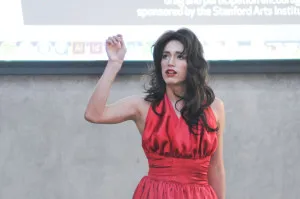
Neal Ulrich ’16 stands on the floor of the d.school atrium, decked head to toe in a dramatic red ball gown, adjusting the top of a chestnut wig to meet his hairline. As eager audience members file in to find seats, they hoot and holler excitedly upon seeing Ulrich. He smiles and laughs, easily 6-foot-4 in his golden high heels. “Sissy That Walk” by RuPaul blares in the background.
After a few minutes, Brianne Huntsman ’15 steps to the front of the atrium and commands the audience’s attention. “Thank you, Dina!” she shouts, motioning to Ulrich, whose oh-so-fabulous drag queen pseudonym happens to be “Dina Mite.” From his place flitting around the room, Ulrich then takes his position. Before long, another RuPaul track crescendos, Ulrich strut-strut-struts across the atrium, bolstered by a wave of cheers. The show begins.
The show was indeed a drag show, entitled “Art as Identity,” and was imagined and executed by Ulrich and Huntsman for a one-time-only performance last week. Funded by the Stanford Arts Institute, the show was a product of a MashUp grant, a flash grant designed for student artists from differing artistic disciplines to come together in making an exciting, collaborative artwork.
Ulrich, a longtime singer and performer, and Huntsman, an experienced costume designer for theater, knew each other from working part time in the LGBT center and their mutual major in product design. They had not, however, collaborated artistically. As they explained, it made immediate sense to them to undertake this project in particular.
“I’ve recently become interested in drag in general,” Ulrich said. “I was talking to Brie very casually about it… Then this grant opportunity came through our mailbox, and she was like, ‘wait, we should do this.’”
Over a grand total of just five weeks (hence the “flash grant”), Ulrich and Huntsman worked to create their show. For her part, Huntsman crafted a full ball gown for Ulrich to wear as Dina Mite— a full-length red dress with golden buttons, complete with a classic Hollywood-style halter-top and flowing train. Over 10 yards of fabric, Huntsman explained, were used for the dress’s skirt section alone. Meanwhile, Ulrich would wear the piece as Dina Mite. To do so, he underwent a significant amount of body modification for the show: he applied drag stage make-up and built feminine-looking hip pads to be worn beneath Huntsman’s dress.
The show started with a campy high-heeled catwalk performance by Ulrich and led into the lip-synch act— a classic formula in popular drag shows today. The song wonderfully and hilariously over-the-top lip-synch to Cher’s “Believe,” complete with exaggerated head bobbles, furious hand and finger waving, dramatic leg flinging and billowing full turns.
The history of drag as an art form, Ulrich and Huntsman explained, is distinctly separate from being transgender. Drag began in mid-20th century Harlem, where groups of black, low-income, LGBT men would organize drag “balls” to dress up, temporarily, as certain identities.
“They would dress up to affect an identity that they could not otherwise belong to,” Ulrich explained. “There was a lot of female impersonation, but also people dressing up as business executives or high fashion models. It was about putting yourself in that place of privilege.”
For Ulrich and Huntsman, drag today occupies a more entertainment-based space in club scenes and television shows, but it still has a socially conscious intention.
“Drag really highlights how we present ourselves and what we think of as feminine,” Ulrich explained. “If I’m saying, I’m dressing up as a woman, what does that mean? [Drag] is making very clear how society defines femininity.”
Huntsman elaborated that drag can also make larger comments on the performativity of any identity, including that of a Stanford student, for example.
“We just wanted to bring conversation about drag and identity to Stanford,” Huntsman said. “You dress yourself in a specific way, and you elicit reactions that you probably want to elicit. Everybody presents themselves in a certain way because they want to be treated in a certain way.”
As the duo wanted to explore such questions, the end of “Art as Identity” also featured a faux-interview series of questions and answers on the subject, in front of the audience.
“It’s about breaking the rules that people say, ‘this is how you have to dress, and this is how you have to act,’” Ulrich said at the end of the performance. “I don’t necessarily want to live my life as a woman, but it’s an exciting transformation… Like, why not? Don’t police my gender!”
Judging from the snaps and shouts in response from the audience that night, many were in agreement.
“What I really want people to do is to show up and have a good time. Dress how you want, come as you are,” Huntsman said of her ultimate intentions for the show. “There is a lot a gender theory behind this…but let’s just take over the d.school for an hour and have fun.”
Hear, hear.
For information on Stanford Arts Institute grant projects and events like “Art as Identity,” visit artsinstitute.stanford.edu.
Contact Katie Straub at kcstraub “at” stanford.edu.
